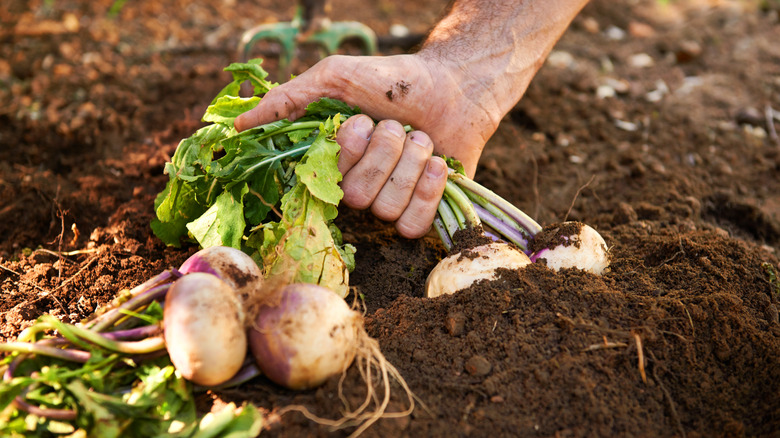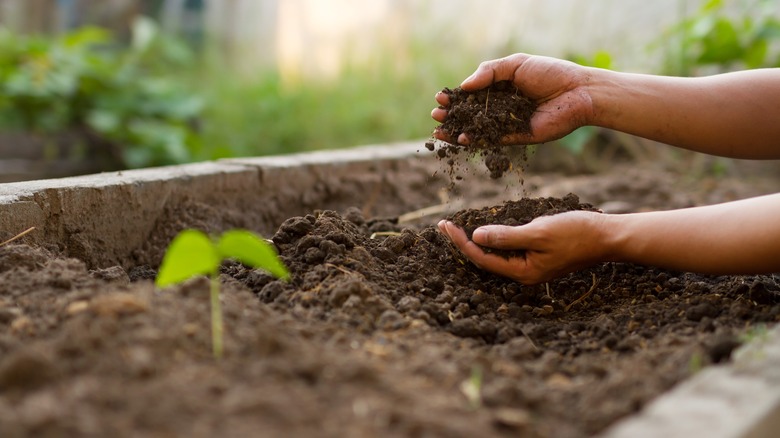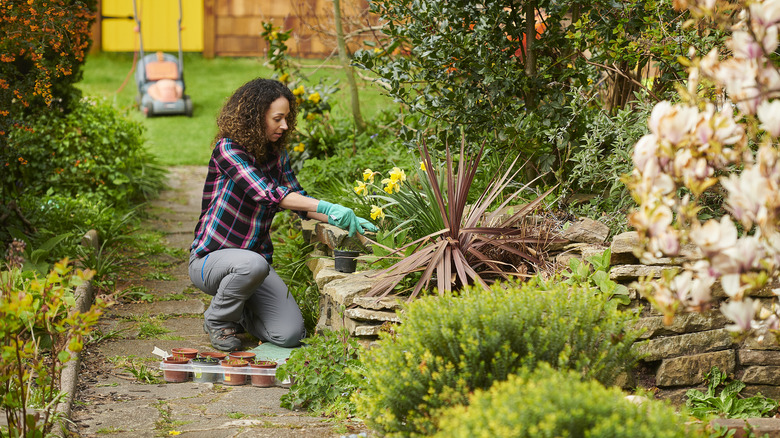Tips To Keep Turnips Plentiful In Your Garden Through Winter
Thinking of growing turnips this winter? It's a wise and rewarding choice, but certain key aspects need your attention for a thriving crop. Belonging to the Brassicaceae family, turnips can thrive in less-than-ideal conditions, making them an excellent choice for winter gardening. However, the secret to a successful turnip harvest lies in selecting the right varieties since winter demands hardier maincrop types. The Royal Horticultural Society advises planting the maincrop turnips between July and mid-August because they're known for their adaptability to cooler climates. This period aligns perfectly with their natural growth cycle, promising a robust autumn harvest that can extend into the new year.
That being said, it's not just about picking the right variety. The success of your turnip crops also hinges on understanding their growth needs and preferences. Turnips are versatile; they can grow both in the ground and in containers, catering to gardeners with varying space and resource availability. In-ground planting requires attention to spacing and depth, ensuring enough room for each plant to develop. On the other hand, container planting demands careful selection of the container size and quality of the compost used. Whether you opt for traditional in-ground planting or container gardening, the initial steps of planting and germination are pivotal in setting up your turnips for a healthy life cycle. Early care, from proper spacing in the ground to selecting the right container size and compost for container gardening, is essential.
Preparing the perfect soil and planting your turnips right
When you're getting ready to plant turnips, the first thing you need to focus on is the soil. Turnips love well-drained, fertile soil, so start by testing your garden's soil pH. According to the University of Minnesota Extension, you should aim for a pH between 6.0 and 7.5. Before planting, incorporate compost or aged manure into your soil to boost nutrient levels. When sowing turnips in the ground, proper spacing is important. Sow your turnip seeds in rows between one and two inches apart. This spacing gives each plant enough room to grow, ensuring they don't compete for nutrients and sunlight. Once your seedlings sprout, and you see true leaves, thin them out. This might seem counterintuitive, but it's vital for giving each turnip enough space to develop properly.
If you're short on space, container gardening is a great option for turnips. Choose a container that's at least 16 inches wide and mix in good-quality compost. Lightly distribute seeds across the surface, ensuring it's a thin layer. Once done, add another layer of compost. Just like in-ground planting, you need to thin the seedlings after sprouting to give them room to grow. Remember, the way you prepare your soil and plant your seeds sets the stage for your turnip crop's success. So, take your time with these steps, and you'll be on your way to a bountiful turnip harvest.
Tackling weeds and ensuring continuous turnip care
Managing weeds is a crucial part of growing turnips. According to the University of Nebraska Lincoln, these root vegetables don't compete well with weeds, especially in their early stages. To start off, consider using a contact herbicide like Gramoxone or Roundup before planting. This pre-emptive strike against weeds gives your turnips a clean slate to grow. But remember, always follow the safety instructions and guidelines when using herbicides. Once your turnips are in the ground, continue to keep an eye on weed growth. Regular hand weeding may be necessary, especially in the early weeks. While it's a bit of manual work, keeping the area around your turnips weed-free is essential for their development. Weeds not only compete for nutrients but also for water and light, which are both critical for your turnips' growth.
Beyond weed control, ongoing care for your turnip plants is equally important. For both in-ground and container methods, watering plays a big role. Turnips require constant moisture. Regularly water your plants, especially during dry spells. However, avoid overwatering, as this can lead to root rot or other diseases. Keep the soil moist but not waterlogged to promote healthy growth. Lastly, as your turnips grow, watch out for pests and diseases. Common issues include maggots and aphids. A good practice is to rotate your crops each year to prevent these pests from becoming a recurring problem.


